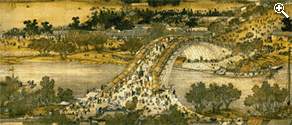
Court Painters,
Ch'ing Dynasty (1644-1911)
Handscroll,
12" x 535"
 |
 |
 |
 |
¡@
The
original upon which this work is based is by Chang Tse-tuan (fl. early
12th c.) and masterful unfolds the Sung dynasty life and customs at the
capital of K'ai-feng in a long handscroll format. This theme, popular in
the Northern Sung (960-1126), has been copied often throughout the ages.
There are seven versions alone in the National Palace Museum, and this one
by court painters of the imperial painting academy under the Ch'ien-lung
Emperor (r. 1736-1795) is one of the most famous. Each version reflects
not only the style of the period, but also the life and appearances of the
time.
This version represents a collaborate work
by five court painters (Ch'en Mei, Sun Hu, Chin K'un, Tai Hung, and Ch'en
Chih-tao) and was finished in 1736. This work can be said to be a copy
that combines the style and features of previous versions along with the
unique customs of the Ming and Ch'ing, such as the entertainment that was
popular then. The lively activities include a theatrical performance,
monkey, acrobatics, and a martial arts ring to lend a festive air to the
scene.
Brilliantly colored and characterized by
sure, fine brushwork, this represents a great example of Ch'ing court
painting. Although this painting has lost much of the archaic feel of the
Sung dynasty version, it is a valuable source of information for late Ming
and early Ch'ing life and customs. The style also reflects the influence
of Western techniques, which were popular in court painting of the time.
The buildings and streets, for example, were rendered with Western style
perspective and even some Western-influenced architecture appears. The
bridge and buildings depicted in the ruled-line method (chieh-hua), and
the figures are also exquisitely detailed.
¡@
